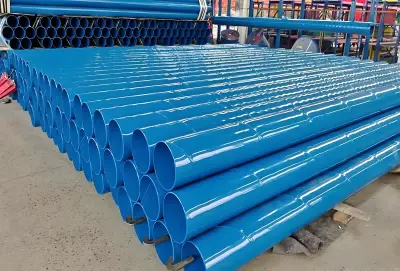When it comes to protecting pipelines in harsh environments, epoxy coated carbon steel pipes stand out as a superior choice. These pipes combine the strength of carbon steel with the corrosion resistance of epoxy coatings, making them ideal for various industries, including oil and gas, water supply, and industrial manufacturing. Understanding the optimal coating thickness and relevant standards is crucial for ensuring the longevity and performance of these pipes. This comprehensive guide delves into the intricacies of coating thickness, industry standards, and their impact on pipe durability.
|
|
|
Optimal Thickness Ranges for Different Pipe Materials
FBE Coating Thickness for Carbon Steel Pipes
Fusion-bonded epoxy (FBE) coatings are widely used for carbon steel pipes due to their excellent adhesion and corrosion protection properties. The optimal thickness for FBE coatings on carbon steel pipes typically ranges from 14 to 16 mils (350 to 400 micrometers). This thickness provides a robust barrier against corrosive elements while maintaining flexibility and resistance to cracking.
For more demanding applications, such as offshore pipelines or high-temperature environments, thicker FBE coatings of up to 20 mils (500 micrometers) may be specified. These thicker coatings offer enhanced protection against mechanical damage and chemical attack, extending the service life of the pipes in extreme conditions.
Epoxy Lining Options for Ductile Iron Pipes
Ductile iron pipes often require internal epoxy linings to prevent corrosion and maintain water quality. The recommended thickness for epoxy linings in ductile iron pipes ranges from 8 to 12 mils (200 to 300 micrometers). This thickness provides adequate protection while minimizing the reduction in pipe diameter.
For aggressive environments or when extended service life is required, thicker linings of up to 16 mils (400 micrometers) may be applied. These thicker linings offer enhanced resistance to abrasion and chemical attack, making epoxy coated carbon steel pipe suitable for industrial applications and wastewater treatment systems.
Coating Thickness Considerations for LSAW Pipes
Longitudinal Submerged Arc Welded (LSAW) pipes, commonly used in large-diameter pipeline projects, require careful consideration of coating thickness. For LSAW pipes, the recommended FBE coating thickness typically ranges from 16 to 20 mils (400 to 500 micrometers). This increased thickness accounts for the higher stress levels and potential for mechanical damage during installation and operation of large-diameter pipelines.
In offshore applications or areas with high soil stresses, multi-layer coatings may be applied to LSAW pipes. These systems often consist of an FBE base layer, followed by an adhesive layer and a polyethylene topcoat. The total thickness of such multi-layer coatings can reach up to 4 mm, providing superior protection against corrosion, mechanical damage, and environmental factors.
Industry Standards: NACE vs. AWWA Guidelines
NACE RP0394: FBE Coating RequirementsThe National Association of Corrosion Engineers (NACE) RP0394 standard provides comprehensive guidelines for the application and performance of fusion-bonded epoxy coatings on steel pipe. This standard outlines specific requirements for surface preparation, coating application, and quality control measures.
According to NACE RP0394, the minimum dry film thickness for FBE coatings should be no less than 12 mils (300 micrometers). The standard also specifies acceptable thickness variations, with the maximum thickness not exceeding 140% of the specified nominal thickness. These requirements ensure uniformity and consistency in coating performance across the entire pipeline system.
AWWA C210: Liquid Epoxy Coating Systems
The American Water Works Association (AWWA) C210 standard focuses on liquid epoxy coating systems for the interior and exterior of steel water pipelines. This standard is particularly relevant for potable water applications and specifies stringent requirements for coating materials and application procedures.
AWWA C210 recommends a minimum dry film thickness of 16 mils (400 micrometers) for liquid epoxy coatings applied to the exterior of steel water pipes. For interior coatings, the standard specifies a minimum thickness of 12 mils (300 micrometers). These thickness requirements ensure adequate protection against corrosion and maintain water quality in distribution systems.
Comparing NACE and AWWA Standards for Pipe Coatings
While both NACE RP0394 and AWWA C210 provide valuable guidelines for epoxy coatings, they differ in their focus and application. NACE RP0394 is primarily concerned with FBE coatings for general industrial use, including oil and gas pipelines. In contrast, AWWA C210 specifically addresses liquid epoxy coatings for water pipelines.
One key difference is the minimum thickness requirements. NACE RP0394 allows for slightly thinner coatings (12 mils) compared to AWWA C210 (16 mils for exterior coatings). This difference reflects the varying priorities and operating conditions in different industries. Project engineers must carefully consider these standards when specifying coating requirements for their specific applications.
Impact of Coating Thickness on Pipe Longevity
Corrosion Protection: Thin vs. Thick FBE CoatingsThe thickness of FBE coatings plays a crucial role in determining the level of corrosion protection provided to steel pipes. Thicker coatings generally offer enhanced barrier protection, reducing the likelihood of corrosive elements reaching the pipe surface. However, the relationship between coating thickness and corrosion protection is not always linear.
Thin FBE coatings (12-14 mils) can provide adequate protection in less aggressive environments and may offer better flexibility and resistance to cracking during pipe handling and installation. Thicker coatings (16-20 mils) excel in harsh environments, offering superior resistance to chemical attack and mechanical damage. The choice between thin and thick coatings depends on factors such as soil conditions, operating temperatures, and expected service life.
Mechanical Properties of Varying Epoxy Coat Thicknesses
Coating thickness also affects the mechanical properties of the epoxy layer, influencing its ability to withstand physical stresses during pipe transportation, installation, and operation. Thicker coatings generally offer improved impact resistance and better protection against abrasion. However, excessively thick coatings may become brittle and prone to cracking under extreme temperature fluctuations or bending stresses.
Optimal coating thickness balances mechanical strength with flexibility. For most applications, a thickness range of 14-18 mils provides an ideal compromise between durability and adaptability to various installation and operating conditions.
Cost-Benefit Analysis of Increased Coating Thickness
While thicker coatings offer enhanced protection, they also come with increased material and application costs. A cost-benefit analysis is essential when determining the optimal coating thickness for a specific project. Factors to consider include the initial coating costs, expected service life, maintenance requirements, and potential downtime costs associated with pipe failures.
In many cases, the additional cost of a thicker coating is justified by the extended service life and reduced maintenance needs. For critical infrastructure projects or pipelines operating in harsh environments, the long-term benefits of thicker coatings often outweigh the initial investment. However, for less demanding applications, a more modest coating thickness may provide sufficient protection at a lower cost.
Selecting the appropriate coating thickness for epoxy coated carbon steel pipes is a critical decision that impacts the longevity, performance, and cost-effectiveness of pipeline systems. By carefully considering industry standards, environmental factors, and specific project requirements, engineers and project managers can optimize their pipe coating specifications. Whether dealing with water distribution networks, oil and gas pipelines, or industrial applications, a thorough understanding of coating thickness implications ensures the best possible protection for vital infrastructure investments.
China Epoxy Coated Carbon Steel Pipe Factory
Hebei Longma Group stands out as a leading manufacturer of epoxy coated carbon steel pipes, offering superior quality and comprehensive solutions for diverse industrial needs. Our state-of-the-art facility boasts advanced production equipment imported from Germany, complemented by four independently developed production lines. With a team of over 300 skilled employees, including 60+ technical experts and a dedicated equipment research team, we ensure unparalleled quality and innovation in every product.
Our commitment to excellence is evident in our comprehensive testing facilities, featuring online ultrasonic automatic flaw detectors and industrial X-ray television for rigorous quality control. We pride ourselves on fast delivery, with the capability to complete standard thickness steel pipe production in as little as 7 days. Hebei Longma Group holds a complete range of certifications, including API 5L, ISO 9001, ISO 14001, FPC, and Environmental Quality System certificates, ensuring compliance with global standards.
Our competitive pricing is achieved through long-term partnerships with raw material suppliers, mature production facilities, and an integrated model that optimizes costs without compromising quality. For top-quality carbon steel pipes that meet API 5L, ASTM A53, EN10210, and AS/NZS 1163 standards, with coating options compliant with DIN 30670, DIN30678, CSAZ245.20, EN10339, ISO21809-1, AWWAC210, and C213, contact us at info@longma-group.com.Our pipes are available in outer diameters ranging from 60.3mm to 1422mm and wall thicknesses from 6.02mm to 50.8mm, catering to a wide array of industrial applications.














